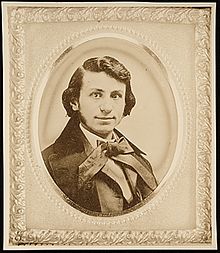Louis Maurer (lithographer)
Louis Maurer (born February 21, 1832 in Biebrich , † July 19, 1932 in New York City ) was a German-American lithographer , painter and photographer .
Life
Maurer was born in Biebrich near Wiesbaden in Germany. He was the oldest of five children. Because he liked to draw, he was apprenticed to a lithographer in Mainz . However, he had to break off this apprenticeship because his father needed him in his carpentry workshop . The Maurer family decided to emigrate to America. In August 1851 they reached New York . Because of his talent, Louis immediately found work as a wood cutter .
In 1852 he started working as a lithographer for the TW Stark Company on Nassau Street in New York. Currier and Ives , the most famous producers of popular decorative lithographs at the time , also resided there . Maurer was promptly lured away for $ 12 a week.
In order to be able to get married, after eight years he switched to a position at Major & Knapp that was paid twice as much . In 1860 he was able to marry Louisa Stein. They had three children together: Charles, Alfred Henry, and Eugenia. Alfred Henry became a painter and belonged to the artist group around Alfred Stieglitz .
During the American Civil War , Mason worked as an instructor for riflemen in Palisades Park . Later he started his own business with the lithography company Heppenheimer & Maurer .
It was not until the age of 50 that Maurer began to study art, first at the Gotham Art Academy and later at the National Academy of Design with the "American Impressionist" William Merritt Chase . In 1884 he retired. He spent his twilight years painting and his hobbies horse riding and shooting.
Works
Louis Maurer created a total of over 100 popular and decorative pictures. This makes him one of the most productive artists at Currier and Ives . His most successful cycle of pictures, Life of a Fireman , established the hero myth of the firefighter profession. His depictions of horse racing, farm life and the American pioneering days were also popular.
The number of copies of his works is unknown, but his lithographs fetch up to $ 10,000 on the art market. His artistic estate was acquired by the American Antiquarian Society in 1935 and comprises 95 drawings, watercolors, oil sketches and 38 commercial prints.
photos
Art historical classification
Although Maurer lived on the threshold of modernity , his art is untouched by modernisms . His view of the society of his time was sober, but also idealizing: social criticism was not his topic. His portrayal of everyday American life was aesthetically indebted to the naturalism of the 19th century, rarely exaggerated into heroic or national pathos, for example when it idealized the heroism of the fire services or romanticized the freedoms of the pioneering days. He got along completely without kitsch.
Modernism then influenced his son Alfred all the more, who traveled to Paris in 1897, where he turned to Fauvism , Cubism and then abstraction . Louis Maurer disagreed and forced his son to return to New York in 1914 by cutting his funds. There the two artists from two antagonistic worlds lived together in one house. The break in modernity led to an indissoluble community of fate through the generation conflict . When the father died in 1932 at the age of 100, the son committed suicide .
swell
- Louis Mason at the American Antiquarian Society
- Louis Maurer at "The Old Print Shop2
- Peter H. Falk: Who Was Who in American Art . Sound View Press, 1985, ISBN 0-932087-00-0 .
Web links
Individual evidence
| personal data | |
|---|---|
| SURNAME | Mason, Louis |
| BRIEF DESCRIPTION | German-American lithographer, painter and photographer |
| DATE OF BIRTH | February 21, 1832 |
| PLACE OF BIRTH | Biebrich |
| DATE OF DEATH | July 19, 1932 |
| Place of death | New York City |



